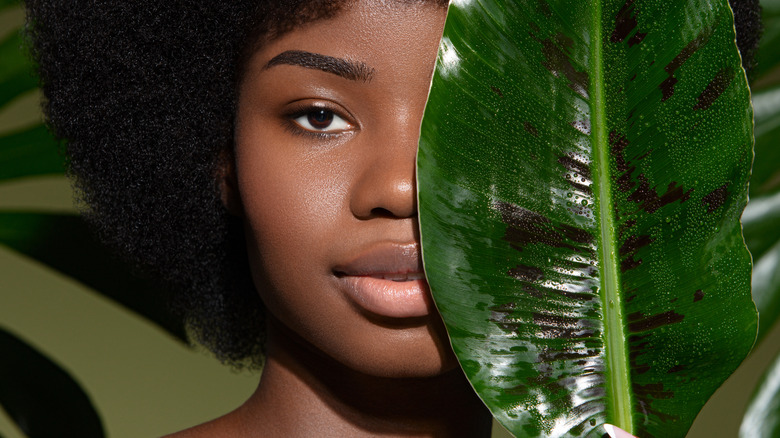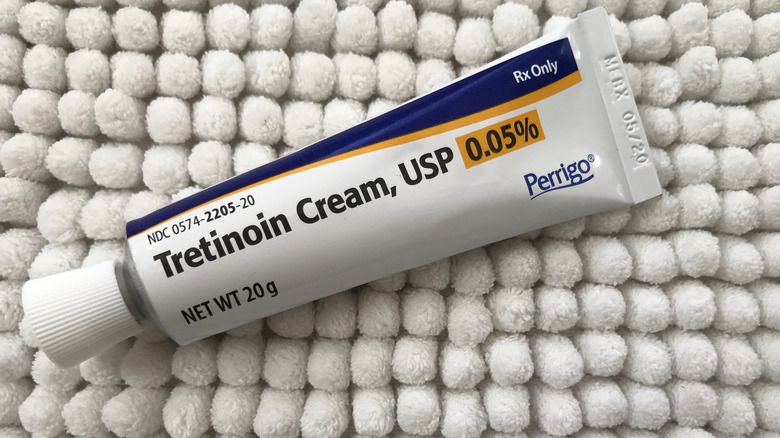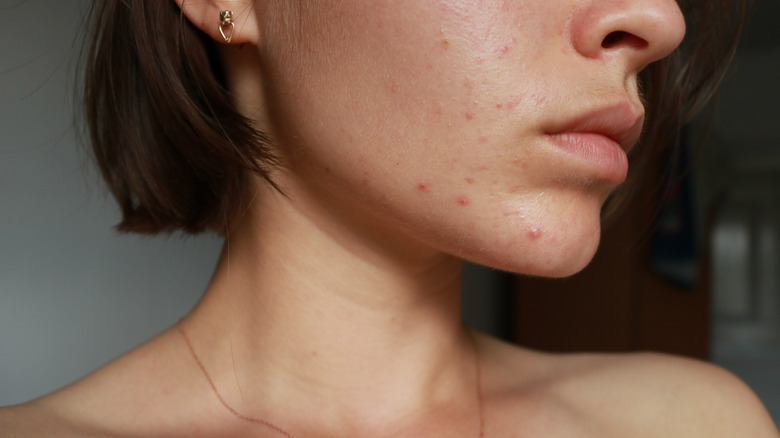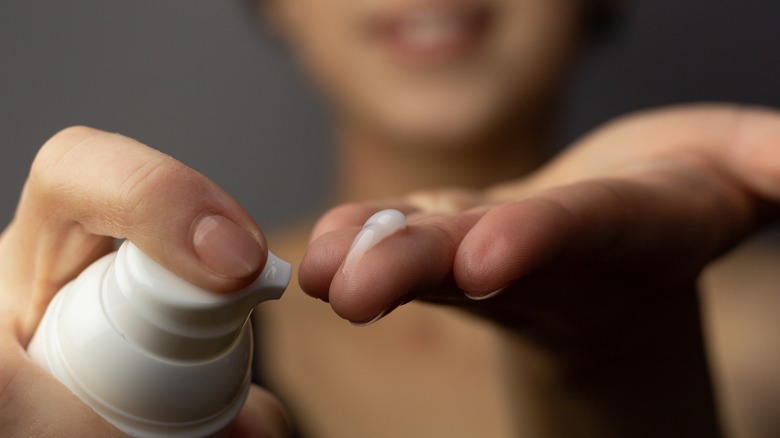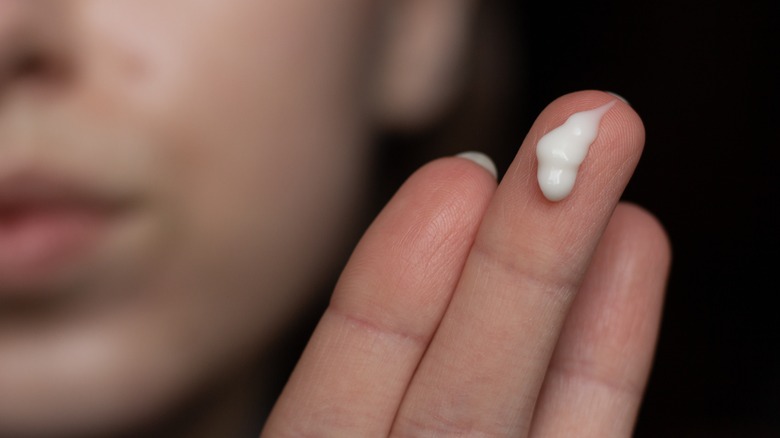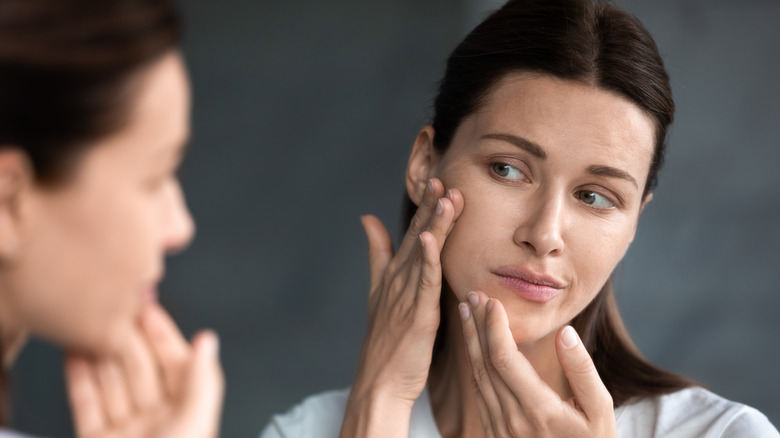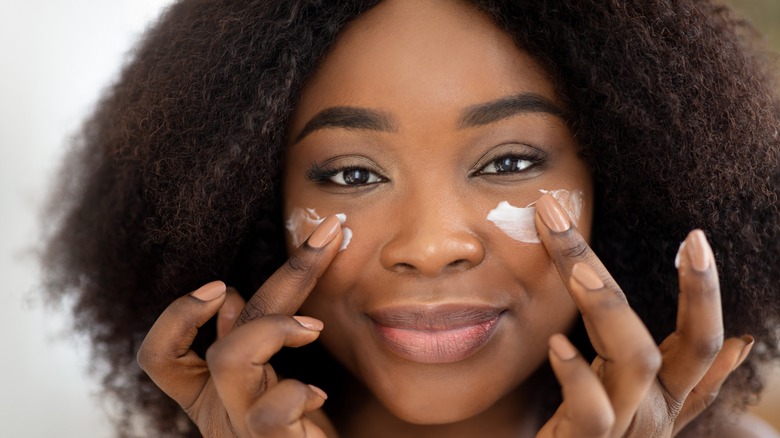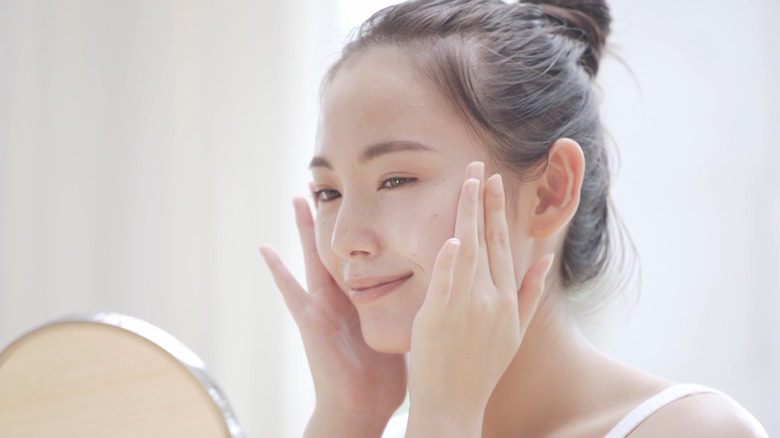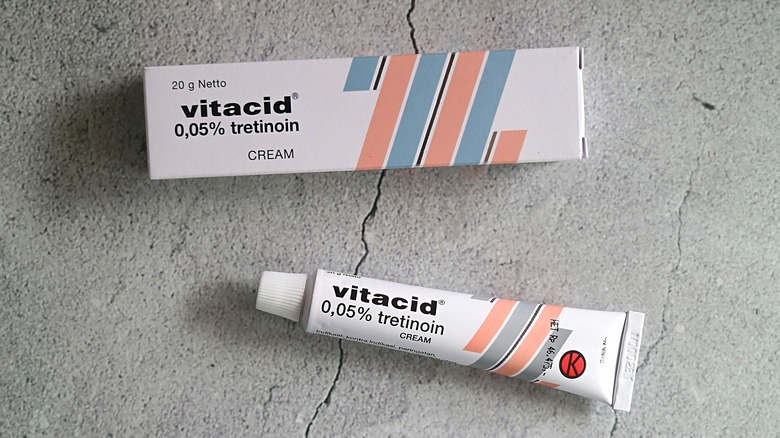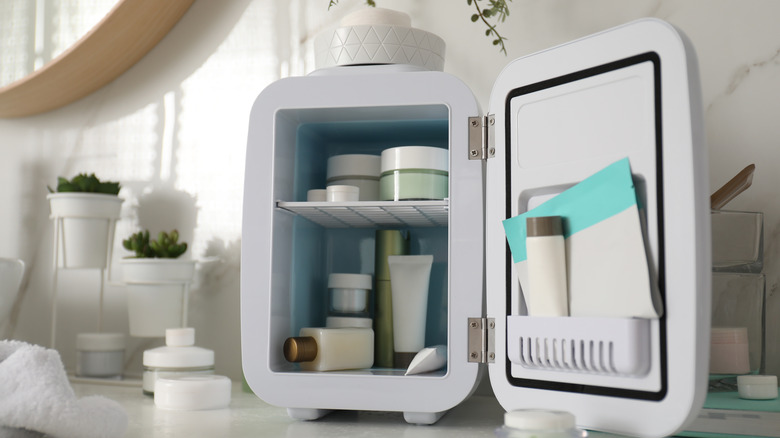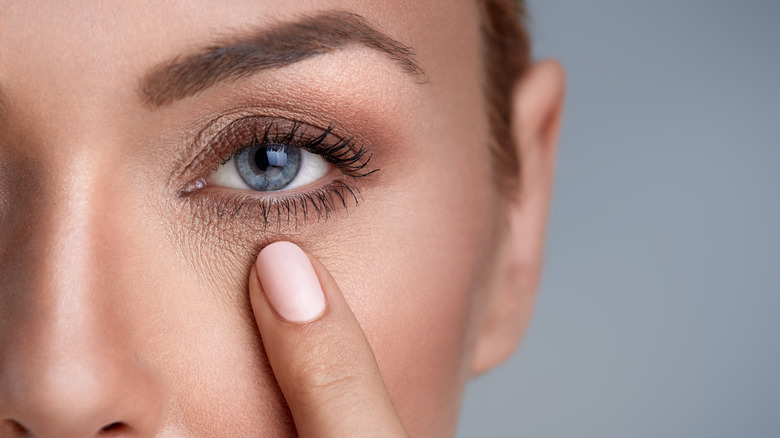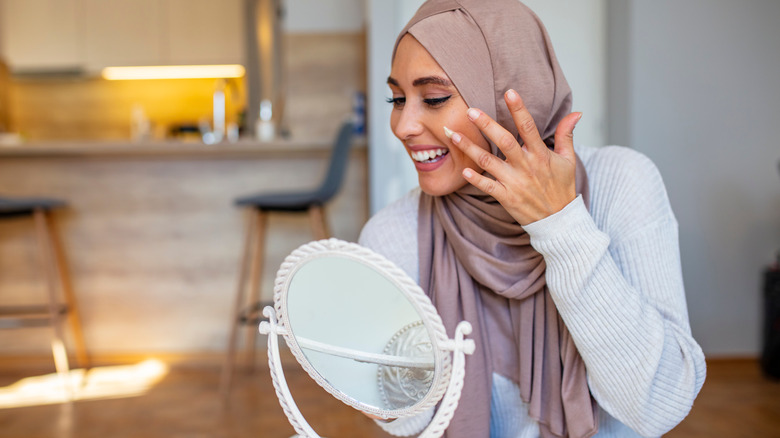What To Know Before Starting Tretinoin For Your Skin
After a decline in 2020 during the COVID-19 pandemic, the global skincare industry is booming once again and is projected to grow to $145.82 billion in 2028 (via Fortune Business Insights). This could be an indication that more people than ever before taking better care of their skin. While your mother or grandmother may have only had one or two skincare products on their bathroom shelves, today there are serums, creams, vitamins, and acids to treat various skin concerns.
Tretinoin is one such product. While it is commonly used to treat acne, the topical cream can actually do so much more than help rid your skin of pesky pimples. According to MedlinePlus, tretinoin is also useful in reducing fine lines and wrinkles, evening out your complexion, and exfoliating your skin. It can also help improve the health of aging skin damaged by long-term sun exposure, according to a 2012 article published in Drugs and Aging (via Springer Link).
Whether you have acne, wrinkles, or sun damage, adding tretinoin to your skincare routine can help improve the overall look of your skin. Are you interested in starting to use tretinoin? Read on to find out all you need to know about it.
Tretinoin is available by prescription only
There are so many skincare products on the market today that it may feel overwhelming to figure out what will work best for you. And while you may be inundated when shopping at your local beauty supply store by all the different options available, there's one product that you won't find on retail shelves: tretinoin. Available by prescription only, tretinoin is sold as a cream or a gel under a few different brand names, including Rejuva, Renova, and Retin-A, according to Healthline.
As a synthetic version of vitamin A, tretinoin belongs to the retinoid family (via Healthline). But because it is actually stronger than naturally derived retinol, your doctor must prescribe it for you. It's so strong, in fact, that those with sensitive skin may not be able to tolerate it well. Those who are pregnant, breastfeeding, or taking certain types of medications should also not use tretinoin.
Tretinoin is often used to treat acne
If you have dealt with acne-prone skin, you may have heard of tretinoin before. According to Healthline, it has been used to treat acne for nearly 50 years. "Acne is a multi-factorial disease with increased dead skin cells filling up in our pores, causing comedones," dermatologist Anna Karp told Byrdie. "Bacteria often colonize the pore, leading to worse acne." One of the primary functions of tretinoin is to help the skin shed dead skin cells before they can form comedones that fill with bacteria.
Because it increases the rate our skin cells turn over, tretinoin also reduces the inflammation that is commonly seen with acne and diminishes acne scars by stimulating collagen and elastin production in the skin, which gives it a more plump, youthful look (via Healthline). This makes tretinoin an effective product for the treatment of acne in both the short-term and the long-term.
What's the different between tretinoin and retinol?
Both tretinoin and retinol are derived from vitamin A, which puts them both in the retinoid category. Some may wonder why they should spend the time making a doctor's appointment to get a prescription for tretinoin when they can buy a retinol product over the counter. It ultimately depends on your skin and your skincare needs.
While both are considered to be retinoids, tretinoin is a much stronger and more powerful version than any over-the-counter retinol product. "Although strengths cannot be compared across the board, it has been observed that retinol is roughly 20 times less potent than tretinoin," dermatologist Dr. David Lortscher explained to Byrdie.
If you are considering tretinoin to treat acne but only suffer from the occasional breakout, non-prescription retinol may be a better fit for you. If you have more serious skin concerns, consult with your dermatologist for help making the best decision.
Use tretinoin carefully
Using tretinoin may seem straightforward to those who have never used it before since it's basically a topical cream or gel, but users — especially new users — do need to exercise some caution. According to Apostrophe, even though you may be anxious to start reaping the benefits of this product, you should definitely start slowly.
It's best to use tretinoin at night on clean, dry skin that is free of other products. Dermatologists recommend applying it 2-3 times per week at first, so you can assess how your skin tolerates it (via Apostrophe). A little also goes a long way with tretinoin and you should use it sparingly. Experts recommend just a pea-sized amount. Tretinoin should only be used topically, so avoid getting it in your eyes, mouth, or nose (via Healthline).
Take care to also protect your skin from the sun and from drying out while you're using tretinoin. "The most important thing with tretinoin use is to make sure that you're using lots of moisturizer and lots of sun protection during the daytime to make sure that you're protecting the skin and also not irritating the skin too much," board-certified dermatologist Dr. Lana Kashlan told Dear Brightly.
Things may get worse before they get better
Although tretinoin is a very effective product, it doesn't work overnight. Like many other skincare products, you may need to use tretinoin for some time — 8-12 weeks according to some experts — before you actually start seeing results (via Apostrophe).
If you're using it to treat acne, your skin may actually become worse with tretinoin before it gets better. According to hims, tretinoin may cause your skin to 'purge' after you begin using it, resulting in (temporarily) worse acne than you started with. Purging is when "new skin cells travel from the inner layers of epidermis up to the surface at a faster rate," which can lead to breakouts, dryness, and peeling in the short term (via Apostrophe). A way to try to avoid the purging effect is to ask your doctor to start you off with a very low dose of tretinoin to begin, then you can slowly work your way up to a stronger dose as your skin adapts.
What are the side effects?
Like any prescription medication, there are some potential side effects that can come with using tretinoin. The most common, according to Apostrophe, are skin redness, dryness and peeling, and sun sensitivity. Fortunately, you can help minimize all of these by practicing some caution while using tretinoin.
Ensuring you're not using too much of the product can help with redness and dry skin, as well as using a calming moisturizer often. Limiting your time in the sun, as well as always using sunscreen with an SPF of 30 or higher is also recommended. In fact, one of the main reasons dermatologists suggest applying tretinoin at night is to help limit sun exposure. Some rare, but possible, side effects include skin discoloration, blisters, and inflammation. If you experience any of these you should stop using tretinoin and contact your doctor.
While these side effects can be inconvenient they typically only last about 2-6 weeks, according to Apostrophe.
Results will take time
While tretinoin is a very powerful topical skin treatment, the results aren't immediate. As we mentioned previously, your skin may actually look worse before it looks better, but the good news is that it won't take forever to see the results you're looking for.
While it varies from person to person, if you are using tretinoin to treat acne, you could start to see a difference in as little as 2-3 weeks, according to Pandia Health. If you are using tretinoin to treat sun damage, you can start to see improvements as early as 3-4 weeks after starting treatment, with darker sun spots fading around 6-8 weeks. Follow up with your doctor if you haven't seen any results after 12 weeks of using tretinoin.
According to Apostrophe, consistency is key in obtaining the results you're looking for. Don't get discouraged if you're not seeing a change in your skin immediately. Just continue using the product as suggested by your doctor.
Gel vs. cream
Tretinoin comes in a gel form and as a cream, and while you may not have given this much thought, there are differences between the two. Your skin type may dictate which form will work best for you.
The gel version of the product actually contains more alcohol than the cream version, which makes it ideal for someone who has oily skin, according to Difference Camp. It also makes the gel better suited to someone who is using tretinoin to treat acne, while the cream may be better for those who are using it to treat aging skin.
The gel, because it is a thinner consistency, will absorb more quickly into the skin. While this will make it work faster, it may also give you more side effects. Because the cream has a thicker consistency that takes longer to absorb into the skin, you may see fewer side effects. The gel also comes in lower strength doses than the cream, according to Strut.
Skincare products safe and not safe to use with tretinoin
Of course, sunscreen is a must for everyone using tretinoin. Not only because your skin will be more sensitive during the first few weeks of using it, but also because the sun also makes your tretinoin less effective, according to Musely.
Because tretinoin can dry out skin, moisturizer can quickly become your best friend. If you're especially prone to skin redness and irritation, some doctors recommend layering your moisturizer by applying it both before and after you apply your tretinoin (via Apostrophe).
Dermatologist Dr. Malvina Cunningham told Skin & Me that you can use a vitamin C product together with tretinoin effectively because they "both promote collagen production and enhance each other's effect." Other active ingredients that complement tretinoin are niacinamide, azelaic acid, salicylic acid, clindamycin, and hydroquinone.
According to Medical News Today, when using tretinoin, it's best to avoid skin products with large amounts of alcohol, astringents, harsh soaps, benzoyl peroxide, and hair removal products.
What areas of skin should you avoid?
While it may be tempting to put a little bit of tretinoin all over your face, there are some areas of skin you should try to avoid. According to Mayo Clinic, while you may have fine lines and wrinkles around your eyes and lips you don't want to apply tretinoin to those areas. If you do get tretinoin on these areas, just wash it away with water as quickly as possible.
How can you fight fine lines and wrinkles in those areas then? Dermatologist Adam Friedman has an alternative solution. He told Byrdie that you can use over-the-counter retinol in these areas instead, while still exercising caution. "As the skin is thin here, its ability to absorb and do its thing is greater and therefore the potential for irritation is slightly greater," he said.
It is also advised not to use tretinoin on skin that is windburned, sunburned, or has open sores (via Mayo Clinic). If you notice any sort of allergic reaction, including blisters or rashes after applying, you should contact your dermatologist immediately.
What age should you start using tretinoin?
For the treatment of acne, research shows that tretinoin is safe and well tolerated in preteens as young as eight, as reported by MD Edge in 2011.
Experts suggest that even if you aren't seeing visible signs of sun damage or fine lines and wrinkle yet, people as young as their early 20s can begin incorporating retinol into their skincare regimen as a preventative measure, before graduating to tretinoin. "The gentle formulation is a great way for acclimating your skin to retinol and providing benefits while you build your skin's tolerance to retinoids so that you can progress into a stronger product over time," licensed esthetician Ali Tobias told Byrdie.
When used properly, tretinoin is a great product to improve the overall look of your skin by helping to get rid of acne and minimize the appearance of fine lines, wrinkles, and sun damage.
